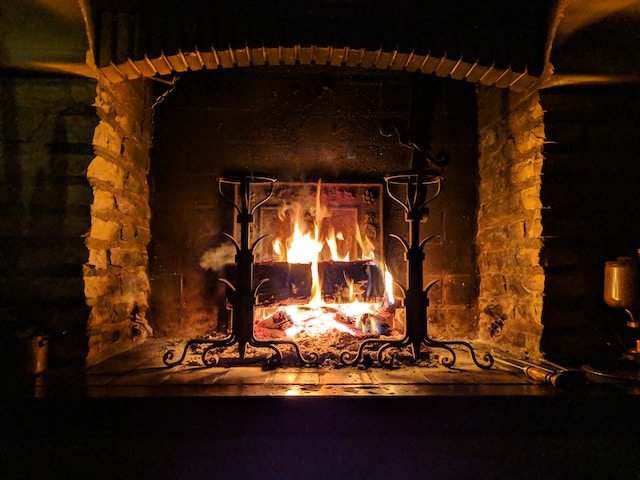Whether a primary bedroom or a basement guest suite, fireplaces add an architectural element to a room that can influence the design flow and atmosphere. Keep your hearth in tip-top shape with new designs.
Simple lines and subtle style offer timeless appeal when it comes to a fireplace’s material selection and trim details. Chalky stacked stones, neutral subway tiles, and farmhouse shiplap remain popular choices.
Horizontal Fireplaces
If a traditional fireplace just doesn’t suit the space, consider a modern horizontal design that blends with the wall when it’s not in use. This sleek fireplace trend is popular among designers who are looking for a bold design that doesn’t look confined to a boxed-in setting.
A sleek ethanol fire can be the focal point of a room that features a flat-screen TV or a large window for a dramatic effect. Acclaimed Los Angeles architect Michael Parks used two EcoSmart Fire XL900 Burners within a custom-built cavity to create an elongated flame for the living room of his stunning Hollywood Hills home. The result is a slender, 6-foot long flame that matches the scale of the room’s large recessed TV.
Alternatively, a concrete linear fireplace is the perfect option for a minimalist fireplace design. Its simple lines and straight, definite edges convey a sense of purity that instantly draws the eye. This fireplace design is also incredibly versatile, blending well with any style of decor from contemporary to transitional and beyond.
Another easy way to update your fireplace is to install a new surround. This simple DIY project adds a whole new look to your existing fireplace without requiring any special tiling skills or tools. Faith of Boxwood Design Co. took her existing brick hearth and fireplace wall from rustic to modern with a faux stone veneer that goes right up to the ceiling.
For an even easier DIY project, consider installing a heat-resistant peel and stick tile surround. These tiles are easy to apply, require no grout, and can be installed directly over your existing fireplace surround for a quick and affordable facelift.
Decorative Screens
One of the best parts about fireplaces is that they come in a variety of shapes, sizes, and styles. This means that you can use them for both functional and decorative purposes. For instance, you can create a stylish and decorative screen that will protect your home from sparks and embers while also adding a focal point to your room design.
There are many ways to style a fireplace screen, and you can choose from a wide range of materials and textures. For example, a wooden or metallic finish can provide a warm ambiance, while a woven mesh screen can add texture and visual interest to your design. You can even find screens with a design that incorporates family portraits or other personal touches.
If you’re looking for something that’s more sculptural, consider a decorative panel screen. These are considered a type of wall art and can be hung on the walls to divide spaces. They can also be used to add privacy and shade to rooms in open-floor plans, and they are available in a number of different colors, patterns, and finishes.
Decorative screens are not just for fireplaces, and you can also use them to add color and texture to a wall in a living room or bedroom. You can also hang them on the ceiling to create a divider in an entryway or hallway.
Decorative screens are also a great way to add an elegant look to your home without having to spend a lot of money. Whether you’re installing them in your living room or kitchen, you can use them to create a focal point and make the space feel more spacious and inviting.
Sconces
Incorporating sconces around your fireplace can elevate the look of your home, while also serving as a lighting source. Burke Decor’s curated collection of wall sconces offers endless possibilities to curate the home of your dreams.
Although sconces and wall lights are both mounted on walls, there are some significant differences in terms of their purpose, design, and functionality. Sconces are generally more decorative and used for accent or ambient lighting, while wall lights serve a more practical purpose of adding general illumination to a space. Some key differences include:
Sconces often come in pairs for a symmetrical design statement, while wall lights usually are single fixtures. Sconces are generally shaped to add dramatic up and downlighting effects, while wall lights are designed to illuminate a larger area with more diffused lighting. Sconces often have shade options, while wall lights do not.
Sconces are ideal for illuminating hallways or staircases, while wall lights are more appropriate for living rooms and bedrooms. In bathrooms, sconces can be installed flanking a mirror or vanity to provide task lighting. Sconces can also be installed above a mantel to highlight artwork, decorative accents, and other items. They are available in a wide range of styles, from modern to classic, as well as in multiple finishes. Many people prefer a bare bulb sconce for a minimal yet chic style, while others choose a more elaborate fixture with intricate details for an eye-catching effect. Sconces are also available with a plug-in option to make them easy to install in your home without the need for hardwiring.
Artwork
Add a focal point above your fireplace with framed artwork. Artwork can help tie the look of your room together, and can also be used to boost resale value. Keep in mind that a good rule of thumb is to have the piece of art be two thirds the size of the fireplace and mantel. In this example, the whites in the artwork link to other white details around the space, helping pull the whole look together. For a more eclectic look, try incorporating pottery or DIY wreaths into your decor. Plants are also a simple way to liven up your hearth.
